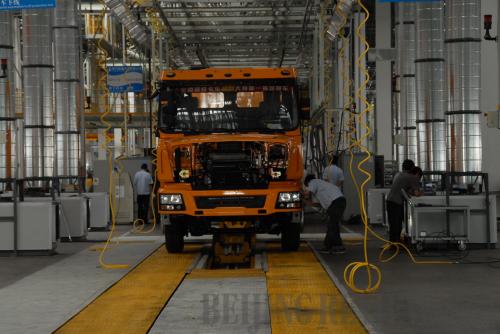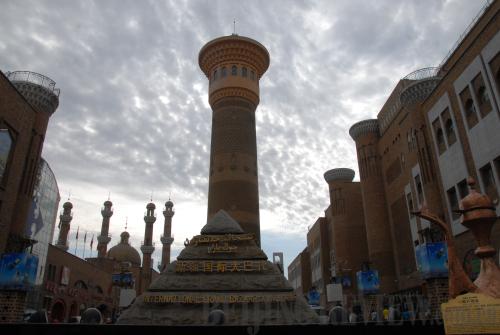|
 |
|
ROLL OUT: Workers assemble a heavy truck in a newly TRADE PORT: A line of trucks newly bought by foreign clients from China wait to clear customs in Horgos Port, bordering Kazakhstan, in Xinjiang Uygur Autonomous Region, on June 10built workshop of Shaanxi Automobile Group Co. Ltd.'s Xinjiang branch in the Urumqi Economic and Technological Development Zone on July 25 (BAI SHI) |
Situated in the remote expanse of northwest China, Xinjiang Uygur Autonomous Region is no longer the "wild west," having grown into a prosperous continental bridge linking China with its neighboring Eurasian countries, benefiting from favorable policies and improved social stability.
Xinjiang is the largest provincial-level administrative region in China, with one sixth of Chinese land territory at an area of 1.66 million square km. It is home to 47 ethnic groups and has abundant natural resources.
With its rich potential and growing array of advantages, Xinjiang is increasingly seen as the focus of a new round of development in China—one that is capable of pursuing a sustainable future.
Despite a hard fall in China's export trade since the outbreak of the global financial crisis in 2008, Xinjiang has enjoyed a steady economic increase in recent years.
According to customs statistics published in early February, Xinjiang achieved a new high in foreign trade through 2011, reaching $22.82 billion and growing 33.2 percent year on year. Exports in 2011 totaled $16.8 billion with a 29.83-percent growth, while imports jumped to $5.99 billion with a rise of 44 percent. Among all 15 cities and prefectures in Xinjiang, the capital city Urumqi ranked at the top in terms of foreign trade volume in 2011, which increased 50.9 percent over the previous year to $9.03 billion.
Such robust growth in cross-border trade is due in large part to Xinjiang's geographical advantage. The region borders eight countries—India, Pakistan, Afghanistan, Tajikistan, Kyrgyzstan, Kazakhstan, Russia and Mongolia—from south to north along its 5,600-km borderline, the longest for a provincial-level region in China. Along with the stable development of Central Asian countries and closer cooperation between China and these neighbor countries, including trading outfits such as the Shanghai Cooperation Organization (SCO), Xinjiang has been playing an increasingly important role in leading economic growth.
He Yiming, head of the Commerce Department of Xinjiang, said that Xinjiang successfully carried out a market diversification strategy through 2011, which focuses on cross-border trade with neighboring countries in Central Asia.
According to He, the cross-border trade between Xinjiang and the five Central Asian countries and Russia reached $17.9 billion in 2011, making up 78.4 percent of Xinjiang's entire foreign trade. Kazakhstan in particular has become the largest trading partner of Xinjiang, with bilateral trade hitting a record high of $10.6 billion last year. Encouraged by the booming trade, the number of import and export enterprises in Xinjiang is also increasing. Among them, firms with assets above $10 million increased to 245 in 2011. The foreign trade realized by the private sector reached $15.4 billion, contributing 67.5 percent of the total volume in Xinjiang. By the end of 2011, Xinjiang had achieved its eighth successive top ranking in terms of land cross-border trade in China.
 |
|
TOWERING HIGH: The minaret of the International Grand Bazaar is a landmark building in Urumqi (BAI SHI) |
The China-Eurasia Expo (CAE Expo) offers a prominent drive for Xinjiang's international trade growth. The annual expo was first held in Urumqi last September. As an upgraded version of the 19-year-old Urumqi Foreign Economic Relations and Trade Fair, the CAE Expo aims to serve as a platform for further expansion of all-around, high-level and multi-field exchanges and cooperation between China, Asian and European countries.
According to official statistics, the total volume of import and export contracts signed during the first CAE Expo exceeded $5.5 billion. The five-day expo attracted 315,808 attendees from China and abroad and 32 foreign countries officially attended as exhibitors. Moreover, SCO member states, including Tajikistan, Kyrgyzstan, Kazakhstan, Russia and Uzbekistan, launched special shows at the expo, introducing their cooperation projects and favorable policies.
In addition to the booming international trade, domestic investment got a strong boost during the first CAE Expo. Enterprises from around the country signed 178 investment contracts with Xinjiang in 14 fields, such as agriculture, energy, heavy industry, tourism and food processing. The contract value reached 185 billion yuan ($29 billion) altogether, growing 77.9 percent from that of the 2010 Urumqi Trade Fair.
With the second CAE Expo to be held in Urumqi on September 1-5, Xinjiang is ready to attract more exhibitors this year.
Chen Ji, Deputy Secretary General of the CAE Expo Secretariat, said that the expo is on its way to becoming a new platform for China to reach out to the entire world.
"The CAE Expo will expand in terms of the number of attendees and exhibition area this year. It is expected that more than 5,000 international buyers from more than 40 countries and regions will attend the expo this September, increasing 25 percent over last year, while 21,000 Chinese companies have applied to participate," Chen said. "The exhibition area will also increase to 89,000 square meters, 10,000 square meters more than the previous one."
Chen feels proud the international reputation of the CAE Expo is burgeoning. "The second CAE Expo will be highlighted by many new international attendees. For example, we have recruited new foreign business associations from Russia and the Netherlands as international sponsors of the event. Companies from Southeast Asia, North America, South Africa, Latin America and Oceania will participate in this year's expo. Xinjiang's market is very attractive to multinationals and international investors," he said.
Chen believes the CAE Expo will further promote economic and cultural relations between China and other countries.
|
